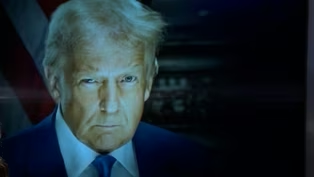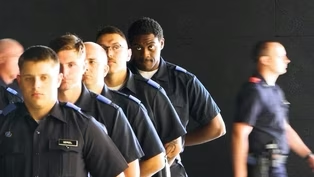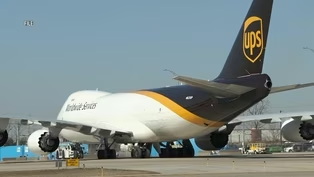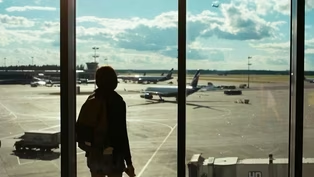
Massive Concrete Sculpture Installed at New Lexington Park
Clip: Season 3 Episode 239 | 4m 2sVideo has Closed Captions
The 16-ton sculpture resembles a fossil commonly found in Lexington's limestone.
A Lexington park is giving visitors the chance to feel like they're stepping into the pre-historic age. Gatton Park on the Town Branch unveiled its first public art istallation. The 16-ton concrete sculpture resembles a fossil commonly found in Lexington's limestone.
Problems playing video? | Closed Captioning Feedback
Problems playing video? | Closed Captioning Feedback
Kentucky Edition is a local public television program presented by KET

Massive Concrete Sculpture Installed at New Lexington Park
Clip: Season 3 Episode 239 | 4m 2sVideo has Closed Captions
A Lexington park is giving visitors the chance to feel like they're stepping into the pre-historic age. Gatton Park on the Town Branch unveiled its first public art istallation. The 16-ton concrete sculpture resembles a fossil commonly found in Lexington's limestone.
Problems playing video? | Closed Captioning Feedback
How to Watch Kentucky Edition
Kentucky Edition is available to stream on pbs.org and the free PBS App, available on iPhone, Apple TV, Android TV, Android smartphones, Amazon Fire TV, Amazon Fire Tablet, Roku, Samsung Smart TV, and Vizio.
Providing Support for PBS.org
Learn Moreabout PBS online sponsorshipA Lexington park is giving visitors the chance to feel like they're stepping into the prehistoric age.
Gavin Park, on the town branch unveiled its first public art installation, a 16 ton concrete sculpture resembling a fossil commonly found in Lexington's limestone.
We spoke to the artist about the inspiration behind the installation.
We've just finished the installation of our first piece of public art to be installed, called First Impressions.
It is a replica of a fossil that is found in the age of limestone found only in Lexington.
And so we're so excited to unveil this.
We came down to visit and everyone said almost the same thing.
They said, the grass is greener, the horses run faster, the water is sweeter, and the bourbon tastes better because of the limestone and the earth.
Limestone is really just calcium carbonate, and calcium carbonate are just fossils left over crushed fossils, one of which is the chlorite shell.
So we thought we would bring the unsung hero up to, to, to be, to interact with.
And that's how we got our idea.
We've been building public art for about ten years, and everything we do starts with the site and the people where it's going.
I mean that that's what makes it, integrated.
So it is really important that we started with the story and we started with, with the right ingredients to make something that would feel, in the end, like it belonged here and it came from here.
This piece is particularly exciting because it happened so early in the process, where you really used it to get people excited about the park and and to broaden their ideas about what could be in this park.
Not only is it a beautiful addition to the park, just a beautiful piece of public art, but it also is interactive.
We hope that children and families and individuals will climb on it and, really get up close and personal with it.
Read the inscriptions.
But we also think it will serve as kind of a small amphitheater, a place for classrooms to meet or book club jobs, those kind of things within the park, kind of off the beaten path off of the trail system and, kind of be an intimate space for people to gather.
We worked very closely with, the Lexington, the state historian and the state, geologist and a really great, group of, of folks from Lexington is, that that helped us formulate key moments of Lexington's history.
And then we took those years and we found other things that were happening all over the world at that same time.
And so, you know, you find out Beethoven was writing a symphony when Lexington was being founded and you can kind of piece together a, global history, you know, sparse, obviously, but but within that, within that fossil, you can kind of piece together our, our, our shared history.
We want them to understand the, the kind of the interconnectedness of all of us on this planet to nature and to each other.
I mean, that sounds like a grand idea, but we really are.
And then to see how brief, you know, humanity has been around for about 6000 years.
The planet's been around for 500 million years.
And it's we want people to kind of explore what that means in terms of the history of the land that we all share and the everything else.
How very neat.
The official opening of the park is expected to be announced this summer.
Can't wait!
Marking President Trump's First 100 Days in Office
Video has Closed Captions
Clip: S3 Ep239 | 1m 49s | The President gets a glowing review from most of Kentucky's federal delegation. (1m 49s)
New Police Training Facility Unveiled
Video has Closed Captions
Clip: S3 Ep239 | 2m 47s | The center is named after a Kentucky deputy killed in the line of duty. (2m 47s)
Report: Tariffs Could Hurt KY More than Other States
Video has Closed Captions
Clip: S3 Ep239 | 3m 11s | A new report says tariffs could hurt Kentucky more because of its reliance on global trade. (3m 11s)
What Does it Take to Get a REAL ID?
Video has Closed Captions
Clip: S3 Ep239 | 4m 35s | Federal enforcement of the REAL ID Act starts May 7. (4m 35s)
Providing Support for PBS.org
Learn Moreabout PBS online sponsorship
- News and Public Affairs

Top journalists deliver compelling original analysis of the hour's headlines.

- News and Public Affairs

FRONTLINE is investigative journalism that questions, explains and changes our world.












Support for PBS provided by:
Kentucky Edition is a local public television program presented by KET



